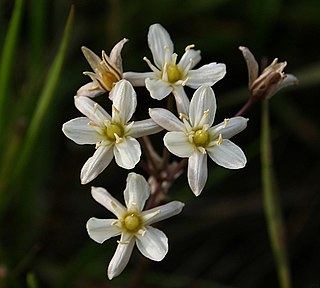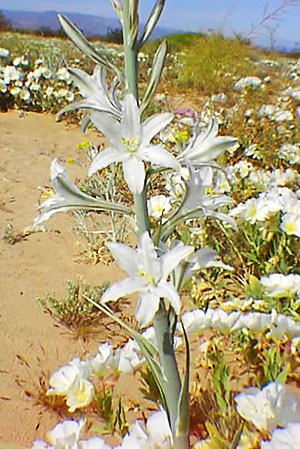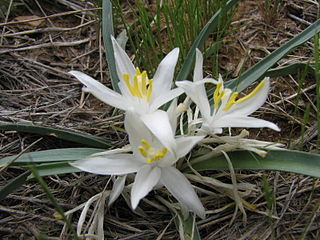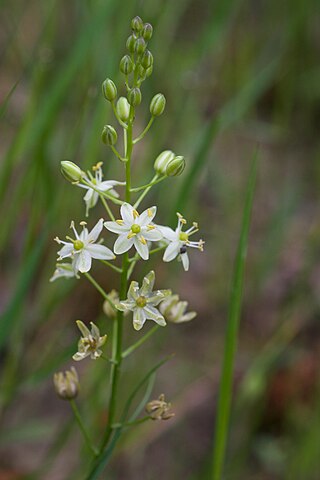
Agavoideae is a subfamily of monocot flowering plants in the family Asparagaceae, order Asparagales. It has previously been treated as a separate family, Agavaceae. The group includes many well-known desert and dry-zone types, such as the agaves and yuccas. About 640 species are placed in around 23 genera; they are widespread in the tropical, subtropical, and warm temperate regions of the world.

Liriope is a genus of low, grass-like flowering plants from East and Southeast Asia.

Brodiaea, also known by the common name cluster-lilies, is a monocot genus of flowering plants.

The genus Muilla includes four to five species of flowering plants.

Scilla is a genus of about 30 to 80 species of bulb-forming perennial herbaceous plants in the family Asparagaceae, subfamily Scilloideae. Sometimes called the squills in English, they are native to woodlands, subalpine meadows, and seashores throughout Europe, Africa and the Middle East. A few species are also naturalized in Australasia and North America. Their flowers are usually blue, but white, pink, and purple types are known; most flower in early spring, but a few are autumn-flowering. Several Scilla species are valued as ornamental garden plants.

Scilloideae is a subfamily of bulbous plants within the family Asparagaceae. Scilloideae is sometimes treated as a separate family Hyacinthaceae, named after the genus Hyacinthus. Scilloideae or Hyacinthaceae include many familiar garden plants such as Hyacinthus (hyacinths), Hyacinthoides (bluebells), Muscari and Scilla and Puschkinia. Some are important as cut flowers.

Nolinoideae is a monocot subfamily of the family Asparagaceae in the APG III system of 2009. It used to be treated as a separate family, Ruscaceae s.l. The family name is derived from the generic name of the type genus, Nolina.
Botanical nomenclature is the formal, scientific naming of plants. It is related to, but distinct from taxonomy. Plant taxonomy is concerned with grouping and classifying plants; botanical nomenclature then provides names for the results of this process. The starting point for modern botanical nomenclature is Linnaeus' Species Plantarum of 1753. Botanical nomenclature is governed by the International Code of Nomenclature for algae, fungi, and plants (ICN), which replaces the International Code of Botanical Nomenclature (ICBN). Fossil plants are also covered by the code of nomenclature.

Dasylirion is a genus of North American plants in the asparagus family, all native to Mexico, with the ranges of three species also extending into the south-western United States. In the APG III classification system, it is placed in the family Asparagaceae, subfamily Nolinoideae.

Asparagaceae, known as the asparagus family, is a family of flowering plants, placed in the order Asparagales of the monocots. The family name is based on the edible garden asparagus, Asparagus officinalis. This family includes both common garden plants as well as common houseplants. The garden plants include asparagus, yucca, bluebell, and hosta, and the houseplants include snake plant, corn cane, spider plant, and plumosus fern.

Hesperocallis is a genus of flowering plants that includes a single species, Hesperocallis undulata, known as the desert lily or ajo lily.

Leucocrinum montanum, commonly known as the sand lily, common starlily or mountain lily, is the only species in the monotypic genus Leucocrinum, placed in the family Asparagaceae, and subfamily Agavoideae. It is native to the western United States, primarily in the Rocky Mountains and the Great Basin.

Agave is a genus of monocots native to the hot and arid regions of the Americas and the Caribbean, although some Agave species are also native to tropical areas of North America, such as Mexico. The genus is primarily known for its succulent and xerophytic species that typically form large rosettes of strong, fleshy leaves. Agave now includes species formerly placed in a number of other genera, such as Manfreda, ×Mangave, Polianthes and Prochnyanthes.

Herreria is a genus of flowering plants native to South America. In the APG III classification system, the genus is placed in the family Asparagaceae, subfamily Agavoideae.
Hemiphylacus is a genus of flowering plants endemic to Mexico. In the APG III classification system, it is placed in the family Asparagaceae, subfamily Asparagoideae.
Petronymphe is a genus of flowering plants endemic to Mexico. In the APG III classification system, it is placed in the family Asparagaceae, subfamily Brodiaeoideae.
Triteleiopsis, common name Bajalily or blue sand lily, is a genus of one known species of flowering plant found in Sonora, Baja California and southwestern Arizona. In the APG III classification system, it is placed in the family Asparagaceae, subfamily Brodiaeoideae.

Speirantha is a genus of one known species of flowering plants found in south-east China. In the APG III classification system, it is placed in the family Asparagaceae, subfamily Nolinoideae.
Triteleia lemmoniae, common names Oak Creek triteleia, Lemmon's star or Oak Creek triplet lily, is a plant species now classed in the family Asparagaceae, although older classifications would have regarded it part of the Liliaceae.

Schoenolirion wrightii, known as Texas sunnybell, is a species of flowering plant in the Agave subfamily. It is native to the southern United States, in Texas, Louisiana, Arkansas, and Alabama. Texas sunnybell produces vertical rootstocks topped with prominent bulbs, each up to 17 mm (0.67 in) in diameter. Between two and seven leaves are produced per plant, up to 34 cm (13 in) long and only 6 mm (0.24 in) across each, flattened to slightly keeled and usually shorter than the flowerhead. The ovate to lanceolate tepals are white with a green stripe on the back, mostly three-veined, but sometimes five-veined. Schoenolirion wrightii flowers between March and May, occurring in sandstone outcrops, wet pinelands, and boggy places.


















